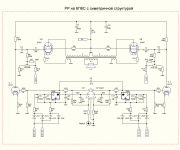Because there is measurement, and there is listening. There are people who love the sound of harmonic-rich amplifiers (mostly second harmonic), and they find the sound more presurable than a low THD amplifier with dominant odd harmonics like a typical push pull. If we all just chase low THD, then we will end up throwing away the tubes and using modern solid state amplifiers. But that's not fun 🙂why to make 5 triodes in the input stage to get 7 watts at the output with TND 3%????
There's no need to advertise the Wolverine it speaks for itself.Is this a primitive advertisement for a transistor amplifier in a forum thread about tube amplifier ?
I saw the post pop up on the recent post list.
It's actually a genuine question. Why do you guys build amplifier with so much distortion. Don't you want to listen to a recording as it was recorded.
So I'm trying to understand why.
We build tube amps simply because they almost always sounds better to our ears and closer to the real music, way better than bunch of THD= 0,00000...% AB-class solid state amps which usually sounds sterile and far away from the real music ,
but wait ,actually those HQ-SS amps are very good for some specific laboratory use where ultra-low THD is for paramount importance .
but wait ,actually those HQ-SS amps are very good for some specific laboratory use where ultra-low THD is for paramount importance .
There are people who love the sound of harmonic-rich amplifiers (mostly second harmonic), and they find the sound more presurable than a low THD amplifier with dominant odd harmonics like a typical push pull.
expected answer
heard it 10500 times
but it's a stereotype and a misconception
if the TND is achieved by "horse doses" of feedback - then your idea is valid
but! if low distortions are achieved by maximally selected identical output stage tubes, low feedback level (4-6 dB) and careful tuning with a spectrum analyzer - then THIS IS REAL TUBE SOUND!
There is no definition of "real tube sound". It means different things to different people.then THIS IS REAL TUBE SOUND!
Anyway, I'll stop now, because we are talking about highly subjective things.
AND THEN - can a 5 watt tube amplifier with a 5% TND play a drum hit?
there will be some sound - but what kind?!!
another thing - a pen-dod PP in Class A with a power of 20 watts - there the chest will vibrate from the drum hit!
true - only on acoustics with high sensitivity with a paper diffuser
there will be some sound - but what kind?!!
another thing - a pen-dod PP in Class A with a power of 20 watts - there the chest will vibrate from the drum hit!
true - only on acoustics with high sensitivity with a paper diffuser
Anyway, I'll stop now, because we are talking about highly subjective things.
formally - you are right
but instead of building another triode amplifier with a bunch of driver tubes and a power of 7 watts at 4% THD - wouldn't it be better to make a 20 watt pentode Class A amplifier with 4-6 dB feedback, even on a prototype?
it's 2 times less expensive - and the result will definitely surprise you!
if you use EL84 - you can do without 6n1p triodes
then the circuit acquires amazing laconicism, beauty, elegance
and you can put your Soul with rapture into the output transformer with cathode windings
then the circuit acquires amazing laconicism, beauty, elegance
and you can put your Soul with rapture into the output transformer with cathode windings
Because there is measurement, and there is listening. There are people who love the sound of harmonic-rich amplifiers (mostly second harmonic), and they find the sound more presurable than a low THD amplifier with dominant odd harmonics like a typical push pull. If we all just chase low THD, then we will end up throwing away the tubes and using modern solid state amplifiers. But that's not fun 🙂
Lamps vs transistors. Again...
Electromechanical effect in tubes works even when listening through headphones, when speakers are not working. This is what makes it possible to develop good-sounding amplifiers on tubes, not what they say in popular fairy tales about even harmonics.
Any effect can affect the sound positively or negatively depending on the magnitude and frequency dependence.
Of course, excessive microphonic and electromechanical effects must be dealt with.
But trying to reduce these effects to zero is a complete misunderstanding of the reasons for the prospect of tubes in sound devices.
(and if you attach a vibrator, transistors will sound too!).
It's worth it. Lamps forgive a lot. If on semiconductors you have to manage to make something sounding, on tubes you have to jump out of your pants to make something quite bad.
(I wouldn't say that)
Translated with DeepL.com (free version)
The Universal PP Driver on your web page?
What role do the stages play on the 2SK2700?
How is the power supply of these cascades organized - I mean “10M45S” from the “Visio-Opus5_0_Amp” diagram
- Home
- Amplifiers
- Tubes / Valves
- What tube amp to build
